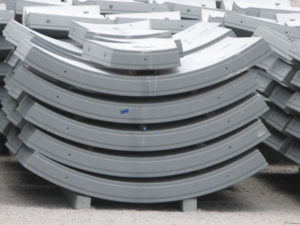
About
Precast concrete is a construction product produced by casting concrete in a reusable mold or “form” which is then cured in a controlled environment, transported to the construction site and lifted into place (“tilt up”). In contrast, standard concrete is poured into site-specific forms and cured on site.
Advantages of Precast Concrete
As long as there has been concrete it has been precast-going clear back to the Romans (see Anne Balogh’s take on that in this section about Concrete Architectural Accents). And there are lots of good reasons for that. The National Precast Concrete Association has information on its website outlining the value of precast concrete. Most of the advantages they cite are really advantages of concrete in general rather than specific to precast, but when compared to site-cast concrete, precast does have lots of advantages:
- Since precast is manufactured in a controlled casting environment it is easier to control the mix, placement, and curing
- Quality can be controlled and monitored much more easily
- Since a precaster can buy materials for multiple projects, quantity discounts can lower costs
- Weather is eliminated as a factor-you can cast in any weather and get the same results, which allows you to perfect mixes and methods
- Less labor is required and that labor can be less skilled
- On site, precast can be installed immediately, there is no waiting for it to gain strength and the modularity of precast products makes installation go quickly
- Repeatability-it’s easy to make many copies of the same precast product; by maximizing repetition, you can get plenty of value from a mold and a set-up
- Accelerated curing, by heating the precast parts, greatly increases strength gain, reducing the time between casting the part and putting it into service
- With the ability to so tightly control the process, from materials to consolidation to curing, you can get extremely durable concrete
Decorative Precast Applications
Looking at the entire concrete industry, there are lots of applications for precast concrete, including:
- bridge beams
- double Ts
- hollow-core slabs
- septic tanks/manholes
- pipes/culverts
- foundation walls
- architectural panels
- traffic barriers and retaining walls/soundwalls






I appreciate you letting us know that we won’t have to worry about what the weather is like when we start our project since precast concrete will deliver the same results, rain or shine. My husband and I are in need of a new concrete patio, and we are wondering if it would be worth it to go with the precast option. W will definitely have to get this type of product since it has been raining quite a bit lately.